
Dimdima
Online Children's Magazine from India

Dimdima
Online Children's Magazine from India
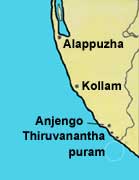
The Periyar and other rivers that flow into the sea, carry with them an oily, semi-liquid mud that gets deposited out at sea. When the monsoon breaks, this accumulation of mud gets stirred up and is dispersed below the surface. These mudbanks, as they are called act as a barrier and keep the water on the landward side calm even in stormy weather.
In former times, Arab traders made good use of the safe anchorages provided by these mudbanks all along the Malabar coast.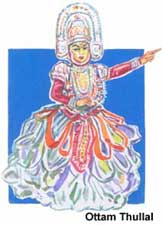
From Alappuzha to Kollam is an 85-kilometre journey which takes one through picturesque backwaters, where water lilies and lotuses bloom and waterbirds wade. Along the way, one can stop at the Sri Krishna temple at Ambalapuzha. The rice payasam (kheer) offered as prasad here is famousIt is here that the art form known as Ottam Thullal originated.
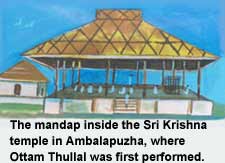 According to the story, the poet Kunjan Nambiyar used to play the mizhavi (a large pot-shaped drum made of copper) for the Chakiar Kuthu, a narrative art form in which members of the Chakiar community use verses from the Puranas to comment humorously or sarcastically on prevailing social conditions.
According to the story, the poet Kunjan Nambiyar used to play the mizhavi (a large pot-shaped drum made of copper) for the Chakiar Kuthu, a narrative art form in which members of the Chakiar community use verses from the Puranas to comment humorously or sarcastically on prevailing social conditions.
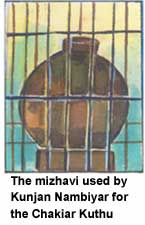 One day during the performance, the poet fell asleep and he was rebuked by the Chakiar who was performing the kuthu. Nambiyar felt humiliated and retaliated by creating the Ottam Thullal, an art form similar to the Kuthu but with dance steps included.
One day during the performance, the poet fell asleep and he was rebuked by the Chakiar who was performing the kuthu. Nambiyar felt humiliated and retaliated by creating the Ottam Thullal, an art form similar to the Kuthu but with dance steps included.
The Mizhavi that Nambiyar had used was installed in the temple compound at the very place where he had staged the first ever performance of Ottam Thullal.
South of Ambalapuzha is the coastal town of Kayamkulam, the birthplace of Kayamkulam Kochunny, the Robin Hood of Kerala. Kochunny used to rob the rich to help the poor. The jail in the town still has the weapons used by the 18th-century bandit.
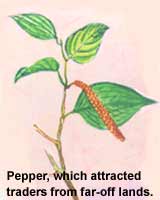 The historic town of Kollam, formerly known as Quilon, lies at the edge of the Ashtamudi lake. It is one of the oldest ports on the Malabar coast and from ancient times, ships of many nations have come here to trade.
The historic town of Kollam, formerly known as Quilon, lies at the edge of the Ashtamudi lake. It is one of the oldest ports on the Malabar coast and from ancient times, ships of many nations have come here to trade.
Pepper was the main attraction. In fact one of the Sanskrit names for pepper 'Kolam' derives from the name of this town.
In the 13th century, the Chinese made Kollam their chief trading post on the Malabar coast. Kollam, then an Independent principality, even exchanged envoys with China.
The holy Sasthamcotta lake in the Kollam district is the only major fresh water lake in Kerala. The Sastham temple near the lake is believed to have been founded by Sri Rama.
Unlike the silvery beaches in the Alappuzha district, the beaches in Kollam look blackish because of the presence of ilmenite, a radioactive mineral. Bauxite is another mineral found on the shores.
Barely 20 kilometres to the south is the coastal town of Anjengo (Anche Thengu). This is where the English East India Company opened its first trading post on the Malabar coast. An old fortress built by the early English settlers still stands there. .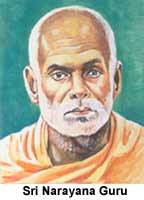
Quite close to Anjengo is Varkala, which is famous as a spa, holiday resort and place of pilgrimage. Mineral water springs spurt out from the sides of the massive red cliffs that rise abruptly from the shoreline.
It was on the Shivagiri Hill of Varkala that Sri Narayana Guru, one of the greatest religious reformers, breathed his last. The guru believed fervently in 'one caste, one religion and one god.' He preached that human beings should constantly improve, whatever their religion.
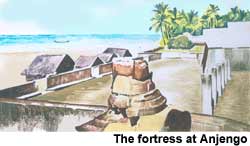 The Janardana temple where Lord Krishna is worshipped as Varkalappan (the father of Varkala) is a pilgrimage centre for Hindus.
The Janardana temple where Lord Krishna is worshipped as Varkalappan (the father of Varkala) is a pilgrimage centre for Hindus.
48 kilometres south of Varkala is Thiruvananthapuram, the capital of Kerala. Thiru Anantha Puram means the abode of Anantha, the holy, thousand-headed-serpent. The city stands on hillocks sloping down to the sea. The city's major landmark is the temple of Ananthapadmanabhaswamy, dedicated to Lord Vishnu. It overlooks the Padma Theertham Tank.
When Raja Marthanda Varma of Travancore made Thiruvananthapuram his capital, he dedicated his entire kingdom to Lord Vishnu.
The Travancore princes prided in calling themselves 'Ananthapadmanabhadasans'. The present temple was constructed in the 18th century. It is said that it was built in 6 months by 4000 masons and 6000 labourers, helped by 100 elephants. It houses the idol of Vishnu reclining on a multi-headed Anantha. A corridor with nearly 4000 pillars skirts all four sides of the rectangular temple enclosure. Carved on each pillar is the figure of a woman holding a lamp in the palm of her hand. When the lamps are lit at dusk, the figures seem to come alive, giving the temple an ethereal look. A flight of steps leads to a seven-storeyed gopuram.
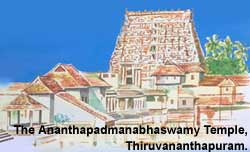 The zoo in Thiruvananthapuram is the second oldest in the country (Calcutta zoo being the oldest). The Sri Chitra Art Gallery has masterpieces of Rajput and Mughal miniatures and has a whole section devoted to the paintings of Kerala's illustrious son, Raja Ravi Varma. There are also specimens of Tibetan, Chinese, Japanese and Balinese art on display.
The zoo in Thiruvananthapuram is the second oldest in the country (Calcutta zoo being the oldest). The Sri Chitra Art Gallery has masterpieces of Rajput and Mughal miniatures and has a whole section devoted to the paintings of Kerala's illustrious son, Raja Ravi Varma. There are also specimens of Tibetan, Chinese, Japanese and Balinese art on display.
The Vikram Sarabhai Space Centre in Thiruvananthapuram was formed in 1972. It provides the technology base for India's indigenous satellite launch vehicle development programme.
12 kilometres south of the capital is Kovalam, a crescent-shaped bay. Kovalam beach is one of the loveliest in India. Massive rocks shelter it from high waves and surges.
Kovalam is also the birthplace of Ayapilla Asan, the poet who wrote ""Ramakathapattu"". Puvar lies almost at the border of Kerala and Tamllnadu. It is here that the Neyyar river which begins 970 kilometres high in the Agastyakudam mountains joins the Arabian Sea.
Last updated on :4/14/2005
Dimdima is the Sanskrit word for ‘drumbeat’. In olden days, victory in battle was heralded by the beat of drums or any important news to be conveyed to the people used to be accompanied with drumbeats.
Bharatiya Vidya Bhavan
K. M Munshi Marg,
Chowpatty, Mumbai - 400 007
email : editor@dimdima.com
Bharatiya Vidya Bhavan
505, Sane Guruji Marg,
Tardeo, Mumbai - 400 034
email : promo@dimdima.com
Dimdima.com, the Children's Website of Bharatiya Vidya Bhavan launched in 2000 and came out with a Printed version of Dimdima Magazine in 2004. At present the Printed Version have more than 35,000 subscribers from India and Abroad.